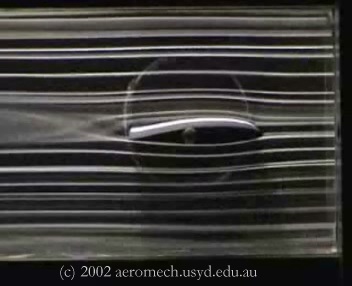|
Of extreme importance before attempting to analyse an
aerodynamic flow is to understand the behaviour of the flow. This
can be done by making the flow visible. The introduction of smoke
lines to follow the airflow, the addition of surface tufts, oils
or sensitive pigments are all methods to allow the investigator
to "see" what is happening.
These visualisations can then be
used to infer the nature of the flow in terms of
circulation, vortex effects, flow separations and turbulence.
This allows appropriate choices or simplifications of the
equations used to solve the flow. Without such visualisation,
incorrect assumptions will lead to the solution of flow cases
that may not be directly relevant to the problem being considered
and hence may lead to large errors.
Some examples of flow visualisation are shown below.
1. Aerofoil section flow.
 |
Smoke visualistion of flow around two dimensional aerofoil section.
Note:
- change in smokeline curvature and spacing as the angle increases.
- slight turbulence on upper surface even at low angles when flow is
attached.
- total separation of flow from upper surface at 15 degrees angle of
attack, indicating stall.
|
| 
